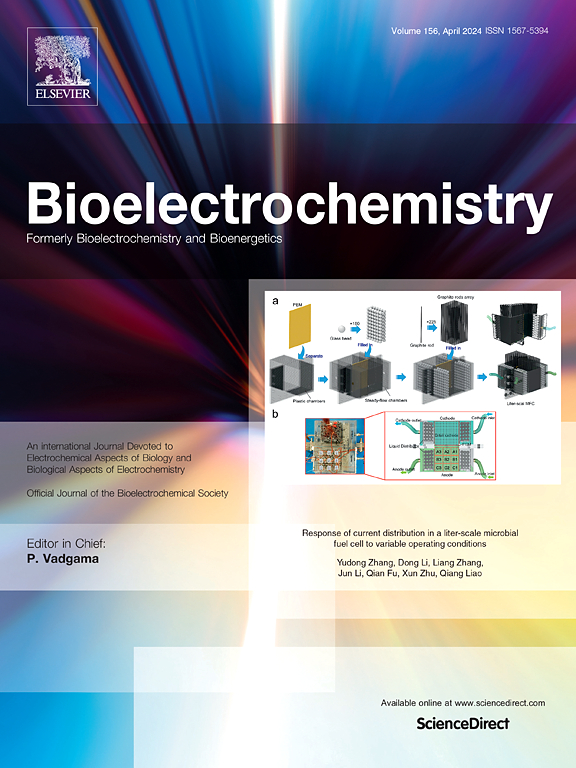基于 PET-RAFT 和 ROP 协同信号放大技术的新型无标记阻抗生物传感器,用于检测 KRAS G12C 突变。
IF 4.8
2区 化学
Q1 BIOCHEMISTRY & MOLECULAR BIOLOGY
引用次数: 0
摘要
KRAS G12C 突变作为重要的生物标志物,与非小细胞肺癌密切相关。本文首次开发了一种新型无标记电化学生物传感器,利用光电池能量转移-可逆加成碎片链转移(PET-RAFT)和开环聚合(ROP)的协同信号放大作用灵敏检测 KRAS G12C 突变。具体来说,发夹 DNA(hDNA)作为生物分子探针,通过 Au-S 键在金电极表面自组装。然后,PET-RAFT 反应的链转移剂 4-氰基-4-[(十二烷基硫代羰基)硫基]戊酸(CDTPA)通过酰胺键连接到 hDNA 上。然后,目标 DNA(tDNA)通过与 hDNA 的碱基互补配对被捕获到电极表面。随后,大量电活性单体 N-acryloxysuccinimide (NAS) 通过 PET-RAFT 反应成功接枝到电极表面,为 ROP 合成的多柔比星-聚己内酯(Dox-PCL)提供了大量接合位点。最后,Dox-PCL 通过酯键连接到电极表面,从而显著放大了电化学信号。在优化条件下,该生物传感器的线性检测范围为 0.1 pM 至 1 μM,检测限为 86.9 fM。该生物传感器具有灵敏度高、特异性强、重现性好和稳定性高等特点,在疾病早期诊断和生物医学研究方面具有相当大的潜力。本文章由计算机程序翻译,如有差异,请以英文原文为准。
A novel label-free impedance biosensor for KRAS G12C mutations detection based on PET-RAFT and ROP synergistic signal amplification
The KRAS G12C mutations, as crucial biomarkers, are closely associated with non-small cell lung cancer. Here, a novel label-free electrochemical biosensor with synergistic signal amplification of photocell energy transfer-reversible addition fragmentation chain transfer (PET-RAFT) and ring-opening polymerization (ROP) was developed for the first time for sensitive detection of KRAS G12C mutations. Specifically, hairpin DNA (hDNA), which act as biomolecular probe, was self-assembled on Au electrode surface by Au-S bond. 4-cyano-4-[(dodecylsulfanylthiocarbonyl) sulfanyl] pentanoic acid (CDTPA), the chain transfer agent of PET-RAFT reaction, was then attached to hDNA via amide bond. After that, the target DNA (tDNA) was captured on the electrode surface by complementary base pairing with hDNA. Subsequently, large numbers of electro-active monomers N-acryloxysuccinimide (NAS) were successfully grafted to the electrode surface via PET-RAFT reaction, which provided plenty of junction sites for doxorubicin-polycaprolactone (Dox-PCL) synthesized by ROP. Finally, the Dox-PCL was connected to the electrode surface by ester bond, significantly amplifying the electrochemical signal. Under optimized conditions, the biosensor has a wide linear detection range of 0.1 pM to 1 μM, with a detection limit of 86.9 fM. Attribute to its high sensitivity, specificity, reproducibility and stability, this biosensor possesses considerable potential in early diagnosis of disease and biomedical research.
求助全文
通过发布文献求助,成功后即可免费获取论文全文。
去求助
来源期刊

Bioelectrochemistry
生物-电化学
CiteScore
9.10
自引率
6.00%
发文量
238
审稿时长
38 days
期刊介绍:
An International Journal Devoted to Electrochemical Aspects of Biology and Biological Aspects of Electrochemistry
Bioelectrochemistry is an international journal devoted to electrochemical principles in biology and biological aspects of electrochemistry. It publishes experimental and theoretical papers dealing with the electrochemical aspects of:
• Electrified interfaces (electric double layers, adsorption, electron transfer, protein electrochemistry, basic principles of biosensors, biosensor interfaces and bio-nanosensor design and construction.
• Electric and magnetic field effects (field-dependent processes, field interactions with molecules, intramolecular field effects, sensory systems for electric and magnetic fields, molecular and cellular mechanisms)
• Bioenergetics and signal transduction (energy conversion, photosynthetic and visual membranes)
• Biomembranes and model membranes (thermodynamics and mechanics, membrane transport, electroporation, fusion and insertion)
• Electrochemical applications in medicine and biotechnology (drug delivery and gene transfer to cells and tissues, iontophoresis, skin electroporation, injury and repair).
• Organization and use of arrays in-vitro and in-vivo, including as part of feedback control.
• Electrochemical interrogation of biofilms as generated by microorganisms and tissue reaction associated with medical implants.
 求助内容:
求助内容: 应助结果提醒方式:
应助结果提醒方式:


